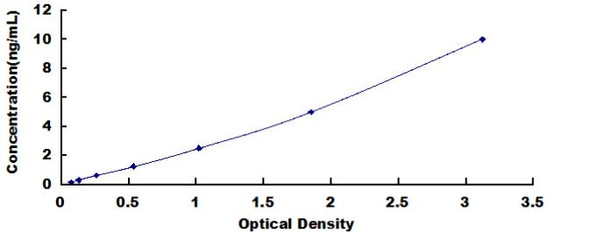Human Vasodilator-stimulated phosphoprotein (VASP) ELISA Kit (HUEB2673)
- SKU:
- HUEB2673
- Product Type:
- ELISA Kit
- Size:
- 96 Assays
- Uniprot:
- P50552
- Range:
- 0.156-10 ng/mL
- ELISA Type:
- Sandwich
- Synonyms:
- VASP
- Reactivity:
- Human
Description
Human Vasodilator-stimulated phosphoprotein (VASP) ELISA Kit
The Human Vasodilator Stimulated Phosphoprotein (VASP) ELISA Kit offered by AssayGenie is specifically designed for the accurate quantification of VASP levels in human biological samples such as serum, plasma, and cell culture supernatants. This kit is known for its high sensitivity and specificity, ensuring reliable and reproducible results for a variety of research applications.VASP is a key protein involved in regulating cell motility and adhesion, making it essential in processes such as cell migration and angiogenesis.
Dysregulation of VASP has been linked to various diseases including cancer, cardiovascular diseases, and neurological disorders, highlighting its importance as a potential biomarker for disease research and therapy development.With the AssayGenie VASP ELISA Kit, researchers can confidently measure VASP levels in human samples with precision and accuracy, providing valuable insights into disease mechanisms and potential therapeutic targets.
| Product Name: | Human Vasodilator-stimulated phosphoprotein (VASP) ELISA Kit |
| SKU: | HUEB2673 |
| Size: | 96T |
| Target: | Human Vasodilator-stimulated phosphoprotein (VASP) |
| Synonyms: | VASP |
| Assay Type: | Sandwich |
| Detection Method: | ELISA |
| Reactivity: | Human |
| Detection Range: | 0.156-10ng/mL |
| Sensitivity: | 0.056ng/mL |
| Intra CV: | 4.8% | ||||||||||||||||||||
| Inter CV: | 7.6% | ||||||||||||||||||||
| Linearity: |
| ||||||||||||||||||||
| Recovery: |
| ||||||||||||||||||||
| Function: | Ena/VASP proteins are actin-associated proteins involved in a range of processes dependent on cytoskeleton remodeling and cell polarity such as axon guidance, lamellipodial and filopodial dynamics, platelet activation and cell migration. VASP promotes actin filament elongation. It protects the barbed end of growing actin filaments against capping and increases the rate of actin polymerization in the presence of capping protein. VASP stimulates actin filament elongation by promoting the transfer of profilin-bound actin monomers onto the barbed end of growing actin filaments. Plays a role in actin-based mobility of Listeria monocytogenes in host cells. Regulates actin dynamics in platelets and plays an important role in regulating platelet aggregation. |
| Uniprot: | P50552 |
| Sample Type: | Serum, plasma, tissue homogenates, cell culture supernates and other biological fluids |
| Specificity: | Natural and recombinant human Vasodilator-stimulated phosphoprotein |
| Sub Unit: | Homotetramer. Interacts with PFN1, PFN2, LPP, ACTN1 and ACTG1. Interacts, via the EVH1 domain, with the Pro-rich regions of ZYX. This interaction is important for targeting to focal adhesions and the formation of actin-rich structures at the apical surface of cells. Interacts, via the EVH1 domain, with the Pro-rich domain of Listeria monocytogenes actA. Interacts with APBB1IP. Interacts, via the Pro-rich domain, with the C-terminal SH3 domain of DNMBP (By similarity). Interacts weakly with MEFV. |
| Research Area: | Signal Transduction |
| Subcellular Location: | Cytoplasm Cytoplasm Cytoskeleton Cell junction Focal adhesion Cell junction Tight junction Cell projection Lamellipodium membrane Cell projection Filopodium membrane Targeted to stress fibers and focal adhesions through interaction with a number of proteins including MRL family members. Localizes to the plasma membrane in protruding lamellipodia and filopodial tips. Stimulation by thrombin or PMA, also translocates VASP to focal adhesions. Localized along the sides of actin filaments throughout the peripheral cytoplasm under basal conditions. In pre-apoptotic cells, colocalizes with MEFV in large specks (pyroptosomes). |
| Storage: | Please see kit components below for exact storage details |
| Note: | For research use only |
| UniProt Protein Function: | VASP: vasodilator-stimulated phosphoprotein. Actin- and profilin-binding microfilament-associated protein. The phosphorylation of VASP is dynamically regulated by cellular adhesion to extracellular matrix. |
| UniProt Protein Details: | Protein type:Cytoskeletal; Motility/polarity/chemotaxis Chromosomal Location of Human Ortholog: 19q13.32 Cellular Component: filopodium membrane; tight junction; focal adhesion; cytoplasm; plasma membrane; cytosol; actin cytoskeleton Molecular Function:protein binding; actin binding; SH3 domain binding; profilin binding Biological Process: axon guidance; positive regulation of actin filament polymerization; actin polymerization and/or depolymerization; neural tube closure; T cell receptor signaling pathway; protein homotetramerization |
| NCBI Summary: | Vasodilator-stimulated phosphoprotein (VASP) is a member of the Ena-VASP protein family. Ena-VASP family members contain an EHV1 N-terminal domain that binds proteins containing E/DFPPPPXD/E motifs and targets Ena-VASP proteins to focal adhesions. In the mid-region of the protein, family members have a proline-rich domain that binds SH3 and WW domain-containing proteins. Their C-terminal EVH2 domain mediates tetramerization and binds both G and F actin. VASP is associated with filamentous actin formation and likely plays a widespread role in cell adhesion and motility. VASP may also be involved in the intracellular signaling pathways that regulate integrin-extracellular matrix interactions. VASP is regulated by the cyclic nucleotide-dependent kinases PKA and PKG. [provided by RefSeq, Jul 2008] |
| UniProt Code: | P50552 |
| NCBI GenInfo Identifier: | 1718079 |
| NCBI Gene ID: | 7408 |
| NCBI Accession: | P50552.3 |
| UniProt Secondary Accession: | P50552,Q6PIZ1, Q93035, B2RBT9, |
| UniProt Related Accession: | P50552 |
| Molecular Weight: | 380 |
| NCBI Full Name: | Vasodilator-stimulated phosphoprotein |
| NCBI Synonym Full Names: | vasodilator-stimulated phosphoprotein |
| NCBI Official Symbol: | VASP |
| NCBI Protein Information: | vasodilator-stimulated phosphoprotein |
| UniProt Protein Name: | Vasodilator-stimulated phosphoprotein |
| Protein Family: | Vasodilator-stimulated phosphoprotein |
| UniProt Gene Name: | VASP |
| UniProt Entry Name: | VASP_HUMAN |
| Component | Quantity (96 Assays) | Storage |
| ELISA Microplate (Dismountable) | 8×12 strips | -20°C |
| Lyophilized Standard | 2 | -20°C |
| Sample Diluent | 20ml | -20°C |
| Assay Diluent A | 10mL | -20°C |
| Assay Diluent B | 10mL | -20°C |
| Detection Reagent A | 120µL | -20°C |
| Detection Reagent B | 120µL | -20°C |
| Wash Buffer | 30mL | 4°C |
| Substrate | 10mL | 4°C |
| Stop Solution | 10mL | 4°C |
| Plate Sealer | 5 | - |
Other materials and equipment required:
- Microplate reader with 450 nm wavelength filter
- Multichannel Pipette, Pipette, microcentrifuge tubes and disposable pipette tips
- Incubator
- Deionized or distilled water
- Absorbent paper
- Buffer resevoir
*Note: The below protocol is a sample protocol. Protocols are specific to each batch/lot. For the correct instructions please follow the protocol included in your kit.
Allow all reagents to reach room temperature (Please do not dissolve the reagents at 37°C directly). All the reagents should be mixed thoroughly by gently swirling before pipetting. Avoid foaming. Keep appropriate numbers of strips for 1 experiment and remove extra strips from microtiter plate. Removed strips should be resealed and stored at -20°C until the kits expiry date. Prepare all reagents, working standards and samples as directed in the previous sections. Please predict the concentration before assaying. If values for these are not within the range of the standard curve, users must determine the optimal sample dilutions for their experiments. We recommend running all samples in duplicate.
| Step | |
| 1. | Add Sample: Add 100µL of Standard, Blank, or Sample per well. The blank well is added with Sample diluent. Solutions are added to the bottom of micro ELISA plate well, avoid inside wall touching and foaming as possible. Mix it gently. Cover the plate with sealer we provided. Incubate for 120 minutes at 37°C. |
| 2. | Remove the liquid from each well, don't wash. Add 100µL of Detection Reagent A working solution to each well. Cover with the Plate sealer. Gently tap the plate to ensure thorough mixing. Incubate for 1 hour at 37°C. Note: if Detection Reagent A appears cloudy warm to room temperature until solution is uniform. |
| 3. | Aspirate each well and wash, repeating the process three times. Wash by filling each well with Wash Buffer (approximately 400µL) (a squirt bottle, multi-channel pipette,manifold dispenser or automated washer are needed). Complete removal of liquid at each step is essential. After the last wash, completely remove remaining Wash Buffer by aspirating or decanting. Invert the plate and pat it against thick clean absorbent paper. |
| 4. | Add 100µL of Detection Reagent B working solution to each well. Cover with the Plate sealer. Incubate for 60 minutes at 37°C. |
| 5. | Repeat the wash process for five times as conducted in step 3. |
| 6. | Add 90µL of Substrate Solution to each well. Cover with a new Plate sealer and incubate for 10-20 minutes at 37°C. Protect the plate from light. The reaction time can be shortened or extended according to the actual color change, but this should not exceed more than 30 minutes. When apparent gradient appears in standard wells, user should terminatethe reaction. |
| 7. | Add 50µL of Stop Solution to each well. If color change does not appear uniform, gently tap the plate to ensure thorough mixing. |
| 8. | Determine the optical density (OD value) of each well at once, using a micro-plate reader set to 450 nm. User should open the micro-plate reader in advance, preheat the instrument, and set the testing parameters. |
| 9. | After experiment, store all reagents according to the specified storage temperature respectively until their expiry. |
When carrying out an ELISA assay it is important to prepare your samples in order to achieve the best possible results. Below we have a list of procedures for the preparation of samples for different sample types.
| Sample Type | Protocol |
| Serum | If using serum separator tubes, allow samples to clot for 30 minutes at room temperature. Centrifuge for 10 minutes at 1,000x g. Collect the serum fraction and assay promptly or aliquot and store the samples at -80°C. Avoid multiple freeze-thaw cycles. If serum separator tubes are not being used, allow samples to clot overnight at 2-8°C. Centrifuge for 10 minutes at 1,000x g. Remove serum and assay promptly or aliquot and store the samples at -80°C. Avoid multiple freeze-thaw cycles. |
| Plasma | Collect plasma using EDTA or heparin as an anticoagulant. Centrifuge samples at 4°C for 15 mins at 1000 × g within 30 mins of collection. Collect the plasma fraction and assay promptly or aliquot and store the samples at -80°C. Avoid multiple freeze-thaw cycles. Note: Over haemolysed samples are not suitable for use with this kit. |
| Urine & Cerebrospinal Fluid | Collect the urine (mid-stream) in a sterile container, centrifuge for 20 mins at 2000-3000 rpm. Remove supernatant and assay immediately. If any precipitation is detected, repeat the centrifugation step. A similar protocol can be used for cerebrospinal fluid. |
| Cell culture supernatant | Collect the cell culture media by pipette, followed by centrifugation at 4°C for 20 mins at 1500 rpm. Collect the clear supernatant and assay immediately. |
| Cell lysates | Solubilize cells in lysis buffer and allow to sit on ice for 30 minutes. Centrifuge tubes at 14,000 x g for 5 minutes to remove insoluble material. Aliquot the supernatant into a new tube and discard the remaining whole cell extract. Quantify total protein concentration using a total protein assay. Assay immediately or aliquot and store at ≤ -20 °C. |
| Tissue homogenates | The preparation of tissue homogenates will vary depending upon tissue type. Rinse tissue with 1X PBS to remove excess blood & homogenize in 20ml of 1X PBS (including protease inhibitors) and store overnight at ≤ -20°C. Two freeze-thaw cycles are required to break the cell membranes. To further disrupt the cell membranes you can sonicate the samples. Centrifuge homogenates for 5 mins at 5000xg. Remove the supernatant and assay immediately or aliquot and store at -20°C or -80°C. |
| Tissue lysates | Rinse tissue with PBS, cut into 1-2 mm pieces, and homogenize with a tissue homogenizer in PBS. Add an equal volume of RIPA buffer containing protease inhibitors and lyse tissues at room temperature for 30 minutes with gentle agitation. Centrifuge to remove debris. Quantify total protein concentration using a total protein assay. Assay immediately or aliquot and store at ≤ -20 °C. |
| Breast Milk | Collect milk samples and centrifuge at 10,000 x g for 60 min at 4°C. Aliquot the supernatant and assay. For long term use, store samples at -80°C. Minimize freeze/thaw cycles. |










